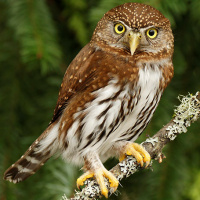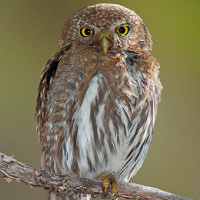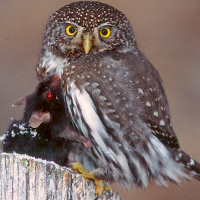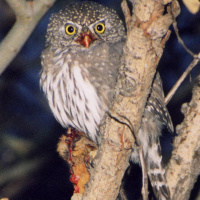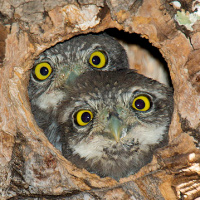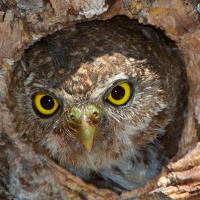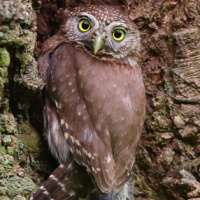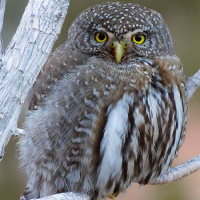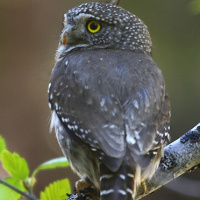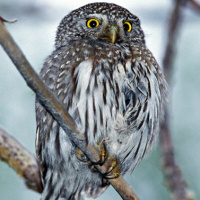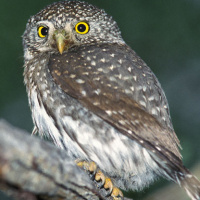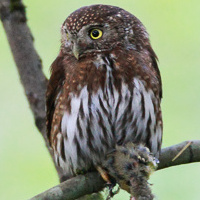Introduction
The Northern Pygmy Owl is a very small woodland Owl with a round, spotted head and no ear-tufts. Grey, red and brown morphs exist, as well as intermediates.
Photo Gallery (12 pictures)
Sound Gallery
Information
Description: Brown Morph: The facial disc is pale greyish-brown with some darker concentric rings and an indistinct rim. The eyebrows
are whitish and the eyes bright yellow. The cere is greenish-yellow, and looks distinctly swollen around the nostrils. The bill is yellowish-horn.
Upperparts are brown, the crown having dense, small whitish spots. The nape has a distinct occipital face (fake eyes) consisting of two large blackish dots
surrounded by a diffuse whitish zone. The rest of the upperparts have some whitish or pale buffish spots, the scapulars having partly whitish outer webs. The
flight feathers are barred light and dark, and the tail feathers are brown with about 6 incomplete whitish bars on both webs.
The throat and foreneck are whitish. The sides of the chest and upper flanks are brown, with several small white spots. The rest of the underparts are whitish
with prominent dark brown streaks.
Tarsi are feathered off-white, and the sparsely bristled toes are greyish-yellow. Claws are greyish-horn with darker tips.
Other morphs: Markings same as the brown morph, but coloured rusty-brown to grey.
Size: Length 17-19cm. Wing length 86-105mm. Tail length 60-79mm. Weight 62-73g. Females are generally larger and heavier than males.
Habits: Northern Pygmy Owls are most active between dawn and dusk. They are very secretive and tend to perch and roost in thickets where it is safe from predators. At times, one will sit atop the highest spire of a tree. At rest, a Northern Pygmy Owl sits with its tail cocked away from vertical, and often twitches its tail when excited. Flight between perches is short and rapid - plummeting downwards as it leaves a perch before leveling off, and swooping up to the next. If the next perch is a tree, it will tend to land low, then moves up through the tree to a higher perch. Flight is relatively noisy for an owl, and resembles a shrike, with rapid wing beats and rounded wing tips. Despite their small size, Northern Pygmy Owls are quite fierce, and will attack prey or drive off intruders several times their own size.
Voice: The primary call of the male is a series of repetitive, whistled hoots "too-too-too-too-too-too-too" at intervals of 1 to 2 seconds, although it is reported that this can vary from 0.5 seconds, all the way up to 4 seconds. This call is territorial in nature and is usually given in the early evening and before dawn, and may be heard year-round. The male gives a high whinnying sound when bringing food to his mate. The female calls much less often and it has a cackling quality. Other calls include an ascending staccato series of whistles. When excited, they may emit a high-pitched trill (8 notes/second).
Hunting & Food: Northern Pygmy Owls are "sit and wait" predators, that hunt mainly by vision, diving down onto prey on the
ground and driving the talons into the prey's throat. they will also attack birds in shrubs, crashing into the
hapless victims. Most prey is carried off in the feet to feeding sites. Birds are usually
plucked before being consumed. They often eat only the brains of birds and the soft
abdomen of insects. One of these little owls can carry prey weighing up to 3 times its own weight.
The Northern Pygmy Owl feeds on a wide range of small prey including small mammals, birds,
and reptiles and amphibians. Voles make up the bulk of their diet, with birds comprising
most of the rest (mainly songbirds, but as large as a California Quail). Other small
mammals include shrews, mice, chipmunks, bats, moles, young rabbits, and weasels. Insects
may be very important when they are most abundant. Other prey taken are toads, frogs and small lizards and snakes.
During winter, surplus prey is cached in a cavity, often in large quantities. Summer caches are usually much smaller.
Pellets are very small, averaging about 3cm long. They are formed only
occasionally as these owls don't consume large amounts of fur, feathers, or bone. The
pellets tend to fall apart shortly after ejection.
Breeding: Northern Pygmy Owls are unsociable birds, remaining solitary
much of the year. During courtship both sexes call to each other with their mating trill.
They also pass food to each other and snuggle closely.
Northern Pygmy Owls are almost entirely dependent on old woodpecker cavities for nest
sites. They will also nest in natural tree cavities. Nest trees are usually dead and are
usually coniferous in the boreal forest and deciduous in more southern areas. Nest
cavities range from 3 to 23 metres (10 to 75 feet) above ground, averaging 6 to 7 meters
(20 to 23 feet). Eggs are laid between April and June, with clutch size ranging from 3 to
7 (3 - 4 average; may increase from south to north). The female does the incubating and
brooding while the male brings food and defends the nest. The incubation period is about
29 days. Unlike all other North American owls, The Northern Pygmy Owl begins incubation
only after the clutch is complete, so that young tend to hatch over a period of 1 to 2
days, rather than one every 1 to 2 days. Young grow quickly, reaching 60% of adult size
after 2 weeks. They fledge at about 30 days, when they are capable of flight. Fledglings
are then fed and defended by their parents for a further 20 to 30 days. Family groups tend
to break up in late Summer or Autumn. Northern Pygmy Owls are single-brooded. It is not
known if replacement clutches are laid. Nest cavities may be used for several consecutive years by the same birds.
Habitat: Northern Pygmy Owls inhabit open coniferous and mixed forests from valley bottoms up to treeline. They do not inhabit dense, continuous forest. In all areas they use forest clearings for hunting - along the edges of meadows, fields, wetlands, and roadsides, and through old burns and logged areas. For roosting they prefer quiet, shady alder thickets. During the breeding season they inhabit open forests with a selection of snags with old woodpecker cavities.
Distribution: West North America, from British Columbia and southern
Alaska south through the Rocky Mountains to California and Arizona, and possibly also to
the mountains in far north Mexico.
Northern Pygmy Owls are essentially sedentary, except for altitudinal movements downslope
in winter. Southward irruptions during winter may occur in years of food shortage.
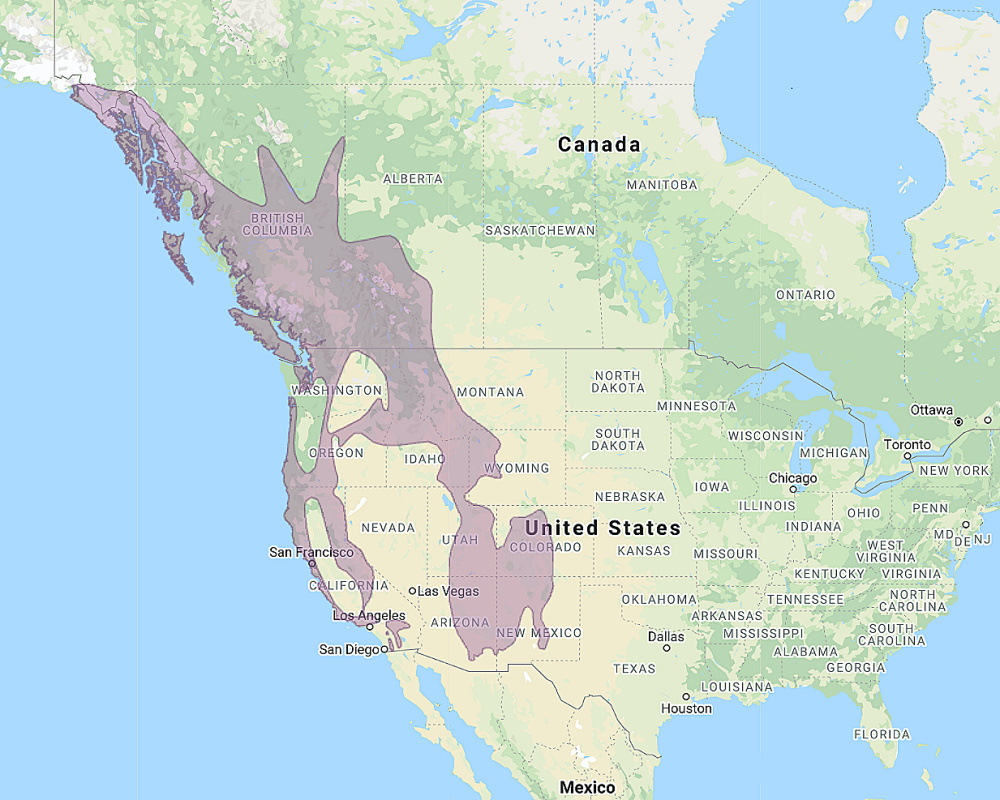
Range of the Northern Pygmy Owl Glaucidium californicum
Status: Locally not rare. Listed as 'Least Concern' by Birdlife International.
Original Description: Sclater, Philip Lutley. 1857. Proceedings of the Zoological Society of London (PZS): Pt. 25, no. 327, p. 4.

